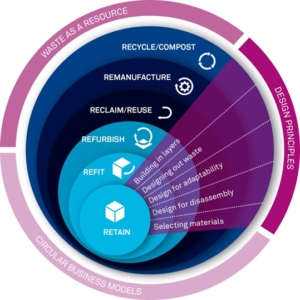After an oversubscribed session in February the Constructing Excellence Sustainability Theme Group revisited the subject of the Circular Economy in Construction on 7th July. The expert speakers were, Robert Spencer, Director of Sustainability, Environment (EMEA) at AECOM, Gilli Hobbs, Director of Resource Efficiency at BRE and Clare Ollerenshaw, Circular Economy Manager at the London Waste & Recycling Board.
Robert Spencer started off referring to the Pont Du Gard aqueduct as an example of the circular economy in construction. Originally built by the Romans nearly 2000 years ago the aqueduct became a toll bridge after the end of its initial life, and subsequently a tourist attraction as today. This raises questions about the end of life of our era’s major infrastructure projects. While we can anticipate this for the individual components of an asset, it’s hard to predict what the tunnels of Crossrail might be used for in 2000 years.
In Robert’s work with AECOM they are trying to go beyond the principles of the circular economy to the practicalities. Using the example of Highways England’s approach to the circular economy

Robert stressed that it was important to build on the efficiency principles already embedded in an organisation rather than spring a whole new set of actions that can seem to riddled with new jargon. Highways England held a stakeholder workshop to ensure a collaborative approach for shaping their approach to the circular economy.
Robert described MI-ROG (the Major Infrastructure–Resources Optimisation Group) which includes many of the largest infrastructure clients in the UK. The group looks at potential scarcity of resources and local bottlenecks as these programmes roll out, making collaboration key.
Robert Spencer, Aecom, 07/07/2016
Gilli Hobbs outlined Building Research Establishment,s (BRE) previous work relevant to the circular economy in construction such as BREEAM, SMARTWaste and design for deconstruction. Gilli emphasised the need for evidence or the danger is that the circular economy concept may just turn out to be ‘greenwash’. She emphasised the importance of measurement even when there aren’t yet defined metrics – the correct ones may only become apparent once you have started collecting data. At the moment there is lots of good work on resource efficiency, and some nice infographics, but Gilli questioned whether it really amounted to true circularity.
Gilli Hobbs, BRE, Resource Efficiency, 07/07/2016
Gilli described the European funded Buildings as Material Banks (BAMB) project which looks at how to return the value of materials at the highest level for the longest period. Including decision making support ‘tools’ that encourages better use of material resources throughout the life cycle of the building. BRE is currently leading development of a methodology whereby the future resource use impact/value can be modelled in new and existing buildings and the application of this methodology via Building Information Modelling (BIM) / Asset Information Modelling (AIM).
For more detail about the BAMB project and contact details to get involved can be found at http://www.bamb2020.eu/
Gilli Hobbs, BRE, BAMB, 07/07/2016
Clare Ollerenshaw gave an overview of the London circular economy route map currently being developed for the Mayor of London by LWARB, of which the built environment is one of the priority areas. Actions include creating a joint fund for circular economy built environment demonstration projects and building the circular economy into the new iteration of the London Plan. The GLA will present the recommended actions in the route map chapters to the Mayor of London and City Hall policy teams to inform upcoming strategies with LWARB providing a review of the routemap each year. More information can be found on their website here http://www.lwarb.gov.uk/what-we-do/accelerate-the-move-to-a-circular-economy-in-london/
Clare Ollerenshaw, LWARB, 07/07/2016
The next meeting of the Constructing Excellence Sustainability Theme Group on 4th October will look at how BIM can improve sustainability outcomes. Members of Constructing Excellence can attend by emailing [email protected]
